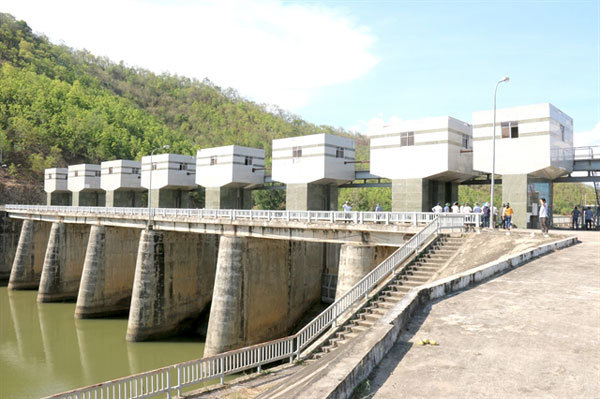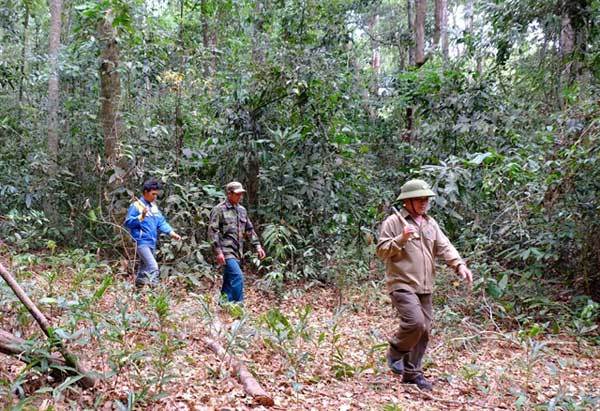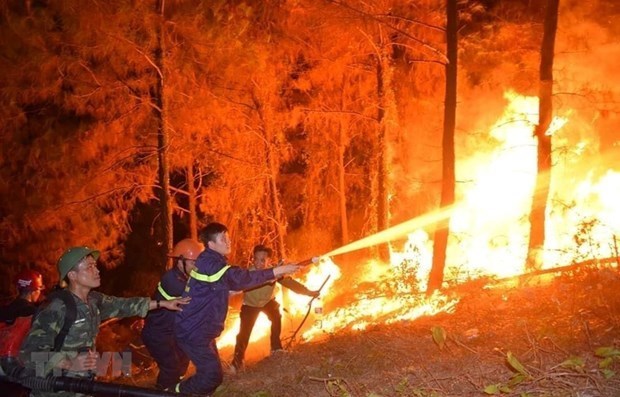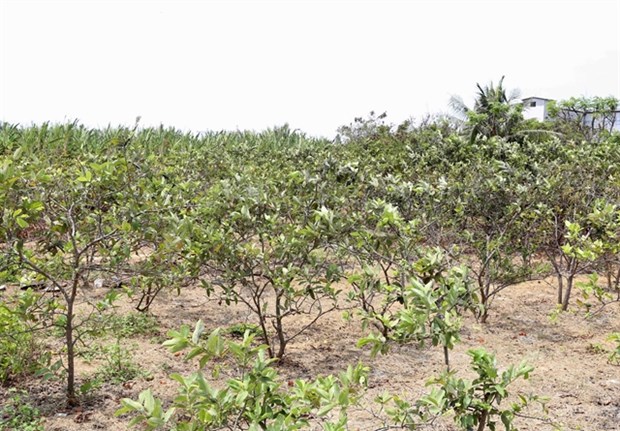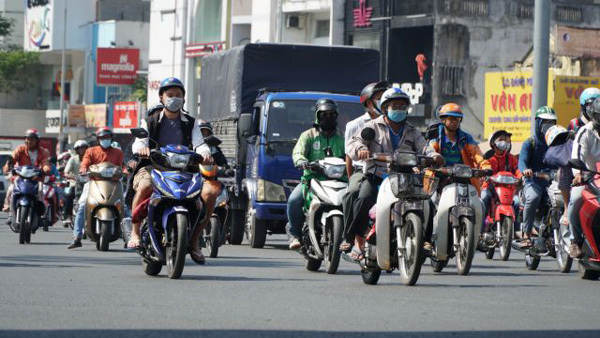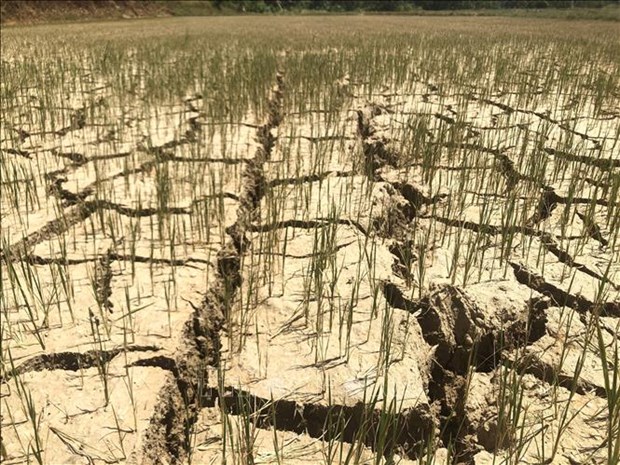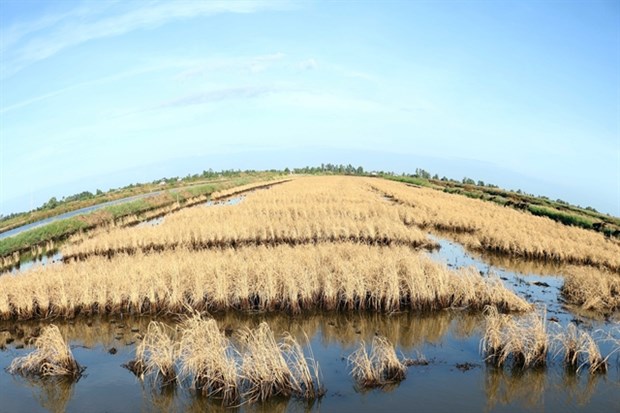- © Copyright of Vietnamnet Global.
- Tel: 024 3772 7988 Fax: (024) 37722734
- Email: evnn@vietnamnet.vn
dry season
Update news dry season
Vietnam's south-central region adjusts farming schedules as drought continues
 The south-central region is estimated to have 51,000 – 70,000ha of farmlands facing a water shortage and a temporary halt to cultivation until there is rain or farmers switch to drought-resistant crops, according to the Department of Irrigation.
The south-central region is estimated to have 51,000 – 70,000ha of farmlands facing a water shortage and a temporary halt to cultivation until there is rain or farmers switch to drought-resistant crops, according to the Department of Irrigation.
Binh Phuoc tightens forest protection in dry season
 Authorities in the southeastern province of Binh Phuoc are tightening measures to prevent forest fires in the dry season as prolonged heat has occurred since the beginning of the year.
Authorities in the southeastern province of Binh Phuoc are tightening measures to prevent forest fires in the dry season as prolonged heat has occurred since the beginning of the year.
Forest fire warning in Ca Mau increased to highest level
 More than 43,500 ha of forest in the Mekong Delta province of Ca Mau is at high risk of fire during the existing dry season, which began in November and will last until the end of May.
More than 43,500 ha of forest in the Mekong Delta province of Ca Mau is at high risk of fire during the existing dry season, which began in November and will last until the end of May.
Saltwater intrusion affects Mekong Delta’s fruit cultivation
 Saltwater intrusion has affected many fruit growing areas in the Mekong Delta as local farmers struggle to secure irrigation water for their orchards.
Saltwater intrusion has affected many fruit growing areas in the Mekong Delta as local farmers struggle to secure irrigation water for their orchards.
Southern Vietnam swelters as month-long heat wave begins
 The southern region, including HCM City, is suffering from a heat wave which is predicted to peak in late March and early April, according to the Southern Hydro-Meteorological Station.
The southern region, including HCM City, is suffering from a heat wave which is predicted to peak in late March and early April, according to the Southern Hydro-Meteorological Station.
Wood-processing factories face fire risks during dry season
 As many as 12 industrial fires have occurred at wood processing factories in HCM City and the neighbouring province of Binh Duong this year, causing major losses of tens billion of Vietnamese dong and hundreds of jobs.
As many as 12 industrial fires have occurred at wood processing factories in HCM City and the neighbouring province of Binh Duong this year, causing major losses of tens billion of Vietnamese dong and hundreds of jobs.
Water issues to be severe in many localities: experts
 Along with Mekong Delta, the central region will suffer prolonged drought and saline intrusion during the rest of this year’s dry season, experts warned.
Along with Mekong Delta, the central region will suffer prolonged drought and saline intrusion during the rest of this year’s dry season, experts warned.
Early forest fire warnings vital
 Nguyen Quoc Tri, director general of the Vietnam Administration of Forestry, talks about the dangers of forest fires during the dry season.
Nguyen Quoc Tri, director general of the Vietnam Administration of Forestry, talks about the dangers of forest fires during the dry season.
Low rainfall expected across central Vietnam over next two months
 Little rainfall is forecast across the country in March and April, the remaining months of the dry season, particularly in the central region, said Vu Duc Long, Deputy Director of the National Centre for Hydrometeorological Forecasting.
Little rainfall is forecast across the country in March and April, the remaining months of the dry season, particularly in the central region, said Vu Duc Long, Deputy Director of the National Centre for Hydrometeorological Forecasting.
Central hydropower plants' reservoirs lack water
 Many hydropower plant reservoirs in the central region are facing water shortages, impacting electricity generation and water reserves for the ongoing dry season from February until July.
Many hydropower plant reservoirs in the central region are facing water shortages, impacting electricity generation and water reserves for the ongoing dry season from February until July.
Mekong Delta takes measures to reduce saltwater intrusion
 Though saltwater intrusion in the Mekong Delta was predicted to come earlier and with higher level of salinity than that recorded in the 2015-2016 dry season, the damages to farming areas are expected to be less serious.
Though saltwater intrusion in the Mekong Delta was predicted to come earlier and with higher level of salinity than that recorded in the 2015-2016 dry season, the damages to farming areas are expected to be less serious.
Vietnam's Mekong Delta residents worry about saline intrusion in dry season
 It is now the flood season in the Mekong Delta, but people there have already begun to worry about saline intrusion in the upcoming dry season.
It is now the flood season in the Mekong Delta, but people there have already begun to worry about saline intrusion in the upcoming dry season.
Drought forecast for central, south-central coastal provinces in 2019
 There is a high risk of drought in the central and south-central coastal provinces as the dry season is forecast to extend to August and even September of 2019, according to the National Centre for Hydro-Meteorological Forecasting (NCHMF).
There is a high risk of drought in the central and south-central coastal provinces as the dry season is forecast to extend to August and even September of 2019, according to the National Centre for Hydro-Meteorological Forecasting (NCHMF).
Mekong Delta to store water during dry season
The Southern Institute of Water Resources Research has asked farmers and irrigation management units in the Cuu Long Delta region to store water in ponds and canals for the dry season this year.
Localities prepare for dry season and forest fires
VietNamNet Bridge – A number of provinces across the country including Lai Chau, Nghe An and Tay Ninh are taking precautions to prevent forest fires as the dry season begins.
Islanders face limited fresh water in early dry season
Half of the farming area on Ly Son Island, 30km off the coast of Quang Ngai Province, has been salinised in the early dry season this year, reducing coverage of the key crop purple onion from 170ha to 50ha.
Preventing fires in dry season
VietNamNet Bridge – The Tay Nguyen (Central Highlands) provinces are taking measures to ensure that 2.56 million hectares of forests are not affected by fire during the peak of the dry season.
Power is sufficient for upcoming dry season: EVN
VietNamNet Bridge – While the backbone of Vietnam’s electricity remains hydropower, the State-owned Electricity Viet Nam (EVN) says power supply will be ensured for the coming dry season.
Red River Delta faces drought
Though the peak time of the dry season has yet to arrive, the water level on the Red, Thai Binh and Day Rivers has been decreasing, posing a risk of water shortage for hundreds of thousands of hectares of farmland.
Climate change makes water scarce in dry season in HCM City
VietNamNet Bridge – Climate change has a huge impact on HCM City’s water resources, the head of its public water utility has warned.
